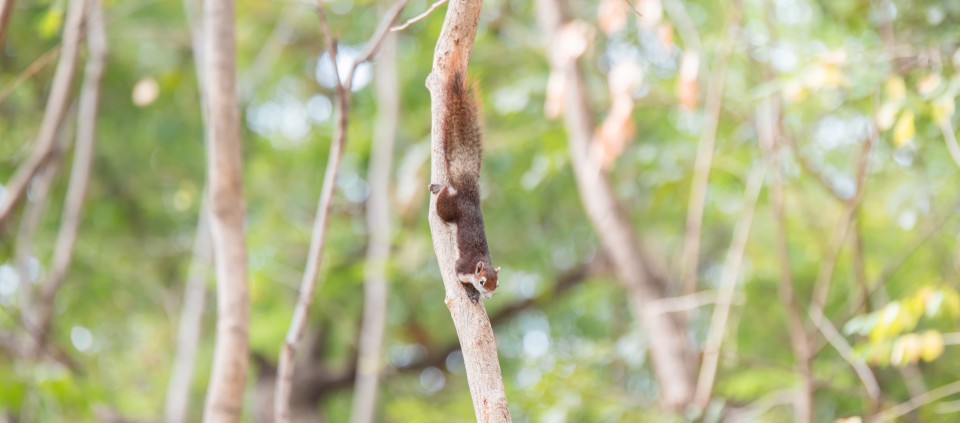Animal Instincts: Communing with Our Spirit Guides

New York City, 2010: It’s springtime in Madison Square Park, where patches of manicured turf are not yet green. I’m grading papers, my coffee and White Out perched on the armrest of a worn wooden bench. I see timid buds on elm trees and New Yorkers trying not to look chilly, but these sights are peripheral. I wear headphones to block out chatter. I have a task to complete.
For a few moments, the squirrel’s presence makes me feel lighter, less burdened. I can put down my red pen and simply observe. I’m newly single, having recently moved into a bare studio apartment after sharing tense space for seven years, and I’m tempted to see the squirrel as a sign, a guide. I know how to survive in this city. But I don’t have to subsist on crumbs anymore, on garbage.
The skeptic in me sees this as anthropomorphizing, a mighty projection. But the yogi in me calls it a visitation. “When we fail to reverence any aspect of nature and our intimate connection to it, we are failing to reverence intimate aspects of our own self,” says Ted Andrews in Animal-Speak: The Spiritual & Magical Powers of Creatures Great & Small. I want to be more reverent.
Later, I receive a deck of Animal Oracle Cards compiled by Steven Farmer, PhD. I flip to the squirrel and read, “Get ready for big changes.” Like quitting my job and moving to western Massachusetts, which will happen the following spring.
Now, seven years later, I ask friends if they have animal guides, and the response is fast and furious. Yes: jaguar, mountain lion, wolf, horse, llama, dog, dolphin, river otter, sea turtle, great blue heron, eagle, hawk, owl, crow, mourning dove, chickadee, hummingbird, dragonfly, earthworm, ant.
I had thought of totems as large animals—lions and bears—due to my earliest exposure to the idea in Jean M. Auel’s Clan of the Cave Bear. In the novel, Ayla is an orphaned Ice Age girl; her adopted clan leader anoints her Cave Lion, a totem usually reserved for males. When I read this book in junior high, the most memorable parts were the sex scenes. But other details were imprinted, too, such as the claw marks on Ayla’s thigh, clear evidence of the cave lion claiming her as its own, and the amulet pouch around Ayla’s neck, which anchors her totem to her heart. Because of Ayla, I wore my own pouch for a time, one made of black velvet and beads, but I didn’t know what to put in it. I was waiting to stumble upon something fearsome, a small bone or tooth. I kept a chestnut there for a while, then a lucky penny. Then I gave it up.
Tina D’Amore, a shamanic healer from Maine, tells me there’s a difference between spirit guides, such as my urban squirrel, and power animals, such as Ayla’s cave lion. Spirit guides tend to show up repeatedly as synchronistic reminders—signs we can choose to pay attention to. But power animals are ordained, often with the assistance of a practiced shamanic guide. We do not choose power animals; they choose us.
We’ve lost touch with these helping guides, says Sandra Ingerman, a prolific author, psychotherapist, and healer, though everyone alive today likely has an ancestor who practiced shamanism. It’s a cross-cultural practice, she says, known to be at least 100,000 years old.
We’ve become disconnected, says Sandra, simply by living in the modern world. Our food is modified. We listen to recorded music instead of going outside to hear the birds. We rely on scented products rather than the natural perfumes of flowers. We stare at screens instead of inventing our own stories. But it’s possible to wake up, Sandra says, by paying attention to both our physical and invisible senses.
Imagine a veil, she says. Behind the veil, another realm exists. Shamans are able to enter this alternate landscape with all their senses intact, where guides appear: ancestral, elemental, or animal. These guides volunteer themselves as helping, compassionate spirits. We tend to think of shamanic journeying as an esoteric, out of body experience, she says, but in fact, it’s a ritual that brings us back into the body, back to our senses.
I think of my city existence and how, for years, I lived rigidly in my mind and paid no attention to my heart and bones.
I have more to learn about shamanic totems. Meanwhile, I can pay attention to signs of spring in and around my woodsy Berkshires home, where I live with my husband-to-be. There are ants on the kitchen counter, wild turkeys and deer in the field, barred owls hooting their mating calls, raccoons pawing though the compost pile, and mice scratching in the rafters. Last year, a bobcat crept around our deck for several stunning minutes. Once, a bear strolled by, intent on locating an uncovered can of birdseed.
It feels like a gift to commune again, even with the mice. Said Chief Dan George of the Tsleil-Waututh Nation, “If you talk to the animals, they will talk to you, and you will come to know them.” In their presence, I’m startled out of myself, away from human concerns. I remember that I’m animal, too.
Lara Tupper writes, sings, and teaches in the Berkshires. She still has an affinity for the busy, playful squirrel. laratupper.com
© Kripalu Center for Yoga & Health. All rights reserved. To request permission to reprint, please e-mail editor@kripalu.org.
Lara Tupper, MFA, is the author of two novels, Off Island and A Thousand and One Nights, and Amphibians, a linked short story collection forthcoming in 2021.
Full Bio and Programs